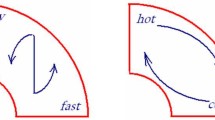Abstract
We consider a solar dynamo mechanism that generates large-scale magnetic fields due to the combined action of cyclonic flows (the α effect), differential rotation (the Θ effect), and the non-uniformity of large-scale magnetic fields (the Θ × J effect). Our results are based on numerical model which takes into account currently available data on the differential rotation of the convection zone and the intensity of convective flows in the solar interior. A reasonable choice of parameters characterizing the intensity of magnetic-field generation by the α and Θ × J mechanisms can account for an oscillatory dynamo regime with properties similar to the 22-year magnetic-activity cycle of the Sun. We analyze the nonlinear saturation of the generation effects in the large-scale magnetic field, due to either magnetic stresses or the conservation of magnetic helicity. Allowance for the helicity of the small-scale magnetic fields is of crucial importance in limiting the energy of the generated large-scale magnetic field.
Similar content being viewed by others
References
F. Krause and K.-H. Raedler, Mean-Field Magnetohydrodynamics and Dynamo Theory (Akademie-Verlag, Berlin, 1980; Mir, Moscow, 1984).
E. N. Parker, Magnetic Field Generation in Electrically Conducting Fluid (Clarendon, Oxford, 1979).
A. Brandenburg and K. Subramanian, Phys. Rep. 417, 1 (2005).
M. Ossendrijver, Astron. Astrophys. Rev. 11, 287 (2003).
H. K. Moffat and M. R. E. Proctor, J. Fluid Mech. 154, 493 (1985).
K.-H. Raedler, Monatsber. Dtsch. Akad. Wiss. Berlin 11, 194 (1969).
K.-H. Rädler, N. Kleeorin, and I. Rogachevskii, Geophys. Astrophys. Fluid Dyn. 97, 249 (2003).
M. Stix, Astron. Astrophys. 47, 243 (1976).
V. V. Pipin, Geophys. Astrophys. Fluid Dyn. 101 (2007) (in press).
M. Stix, The Sun. An Introduction (Springer, 2002).
G. Belvedere, K. M. Kuzanyan, and D. D. Sokoloff, Mon. Not. R. Astron. Soc. 315, 778 (2000).
N. Kleeorin, K. Kuzanyan, D. Moss, et al., Astron. Astrophys. 409, 1097 (2003).
A. Brandenburg and K. Subramanian, Astron. Nachr. 325, 400 (2004).
V. N. Obridko, D. D. Sokoloff, K. M. Kuzanyan, et al., Mon. Not. R. Astron. Soc. 365, 827 (2006).
K. M. Kuzanyan, V. V. Pipin, and N. Seehafer, Sol. Phys. 233, 185 (2006).
Kh. Shang, S. Bao, and K. M. Kuzanyan, Astron. Rep. 46, 424 (2002).
L. L. Kichatinov and V. V. Pipin, Astron. Astrophys. 274, 647 (1993).
Author information
Authors and Affiliations
Additional information
Original Russian Text © V.V. Pipin, 2007, published in Astronomicheskiĭ Zhurnal, 2007, Vol. 84, No. 5, pp. 461–470.
Rights and permissions
About this article
Cite this article
Pipin, V.V. Generation of solar magnetic fields by the αδΘ dynamo. Astron. Rep. 51, 411–420 (2007). https://doi.org/10.1134/S1063772907050071
Received:
Accepted:
Issue Date:
DOI: https://doi.org/10.1134/S1063772907050071




